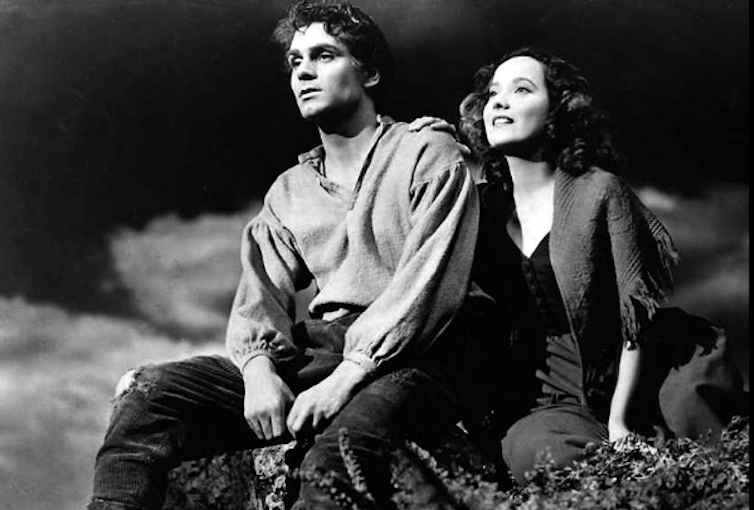With their fierce, independent heroines, brooding anti-heroes and all sorts of dastardly plots, it’s no surprise the Brontë sisters and their novels occupy a special place in screen adaptations of literature.
Emily Brontë’s Wuthering Heights (1847) tends to attract different kinds of film and TV adaptations to the usual polite drawing-room dramas. This is partly because Wuthering Heights is a brutal novel, despite all the romance associated with it. But it’s also down to how Brontë is remembered as an author. In this, her bicentenary year, her enduring appeal as a romanticised figure is much discussed.
This can be traced back to her older sister Charlotte’s own myth-making around Emily following her death in 1848. The myth of Emily relies on her image as a noble savage: a child-like innocent who had little contact with the world beyond her Yorkshire village and beloved moors. Charlotte’s defence relied on the idea that Emily didn’t really know what she was doing when she wrote this extraordinary novel.
It’s easy to understand why Charlotte felt compelled to defend her sister. In the 19th century, writing was still considered a masculine creative act, and taking up the pen as a woman brought accusations of being “unfeminine”. The Brontës existed in the real world and had to navigate their social reputations within it, especially if one of the aims of their writing was economic independence. But Charlotte’s defence of her sister set the scene for how adapters would later approach Emily and her work.
Bringing out Emily
A good example is the 1992 film adaptation of Wuthering Heights starring Ralph Fiennes as Heathcliff and Juliette Binoche as Cathy. This version neatly does away with the novel’s complicated story-within-a-story structure and its two main narrators – housekeeper Nelly Dean and the pompous visitor Lockwood – and instead casts Emily herself as the storyteller.
Played by the waif-like Irish singer Sinéad O’Connor, Emily stumbles upon the ruins of a real house while wandering the moors and, under a mysterious hooded cloak, tells the viewer:
First I found the place … something whispered to my mind, and I began to write.
Emily as a mystical medium is the ultimate visual symbol of how authors are commonly conjured up – as divine geniuses, inspired from above. Of course this is far more attractive than showing the blood, sweat and tears that come with the real craft of writing. But there is something more going on here – something which is representative of wider cultural politics and what often happens with authors like Emily Brontë: they are turned into easily consumable, harmless, generic figures.
Western culture tends to invest in ideas of transcendence around well-known writers. People like to think of them as unique beings who move above and beyond their own cultural and social moments. But when it comes to Emily Brontë, perhaps there is also an unspoken desire to neutralise her complex and subversive engagement with her own world.

An explosive tale, Wuthering Heights is unflinching in its depiction of domestic abuse, racism, women as property and the abuse of social power. The direct, unromantic way in which this is explored in the novel is itself threatening to the social order it portrays, and seems like a subversive act for a female author. Adapting the story as romance sells better, and plays down the book’s uncomfortable brutality, as does the idea of Emily Brontë as an “unworldly” young woman who existed outside of conventional society.
This results in constant adaptations of her novel that rely on almost identical images of natural transcendence, beginning with an image from William Wyler’s hugely popular 1939 Hollywood version starring Laurence Olivier and Merle Oberon. It shows Cathy and Heathcliff together on the moors, which seems to encapsulate for many people what the novel is about. Most adaptations repeat this imagery, but you’d have to search hard to find it in the novel, as Cathy and Heathcliff aren’t really depicted as adult lovers frolicking on the moors.
This iconic imagery is not just due to Hollywood creating a visual “template” for the novel through romance; it’s also the product of how adapters have woven the myth of Emily as a transcendent noble savage into her own characters.
A more realistic Emily
A notable and recent exception is To Walk Invisible, the 2016 BBC biopic of the Brontës, in which the sisters are shown discussing the economic necessity of becoming writers. When debating whether to take up male pseudonyms, Emily, played by a straight-talking Chloe Pirrie, says:
When a man writes something it’s what he’s written that’s judged. When a woman writes something it’s her that’s judged.
This blunt assertion seems to summarise how authors of the past – particularly female authors – are dealt with: who they are as human beings and their specific cultural environment are often ignored. They are rendered harmless and powerless to speak to us in a politicised way about the past we’ve inherited, and about our own world. With Emily, the emphasis is instead on romanticising the female author as a child-mystic, rather than focusing on her fiction as informed adult social critique.
Mythologising an author like Emily Brontë may provide a consistent and comfortable way to “consume” famous writers in contemporary culture, but it does a disservice to the potential for a more complex dialogue between past and present – after all, the realities of power, race, gender and class that Brontë wrote about in the 19th century are still issues being tackled today.
The question is, in 2018, should adaptations continue to collude in the screen legacy of a “safe” Emily Brontë, viewed from a transcending distance, or could they consider a more dangerous, unpredictable Emily who compels the reader to examine forms of power and powerlessness in contemporary times? It’s time to shed the romance for the reality.

